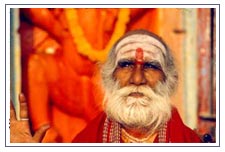
Since
time immemorial, the Himalayas has been recognized as the sanctuary for
ascetics and philosophers. The Himalayas also occupy a central place in
Hinduism. The whole region is considered the realm of Shiva- the supreme
ascetic, and 'Pashupati' - the protecting deity of pastoral herds.
Lord Shiva is worshipped in the form of a lingam - a phallus symbolizing the
male principle in the universe. In his manifestation as the cosmic darer,
the 'Natraja', he rhythmically creates and destroys the cosmos.
Famous shrines like the ice cave at Amarnath in Kashmir, the glacial
formation at Kedarnath in Garhwal, and Jageshwar amidst a thick stand of
deodar in Kumaon are dedicated to him. Kalidas, a resident of Ujjain, a city
of Shiva, aptly described the Himalaya as the dazzling laughter of Shiva.
Nor is Vishnu the protector forgotten here. Interstingly, Sankara, a Saiva
9akso spelt as Shaiv) South Indian saint from Kerala, at the southernmost
tip of India, is credited with the restoration and consecration of the
Badrinath shrine - one of the four major pilgrimages prescribed for a
believing Hindu. It is a 'Dhama' (an important sacred
destination).
Gompas (monasteries) like Hemis and Lamayuru in Ladakh
or Rumtek in Sikkim hold an important place for Buddhist worshippers. Many
of these have preserved with loving care the heritage of Tibetan art and
culture.
There is a venerated Sikh shrine at Hemkund, a high-altitude lake on the
fringer of the Valley of Flowers. Legend informs us that it was here that a
Sikh guru did penance and was rewarded with a divine vision.
Islam and Christianity also have a distinct
presence in the Himalayas. While the Muslims of the valley of Kashmir are
mostly descendants of people who converted to Islam after the conquest by
Muslim invaders, the Ladakhis adopted Islam after encountering it via the
Central Asian trade route. On India's northeastern frontier, Christian
missionaries won many converts among the tribes. Proselytizing has gone hand
in hand with the spread of education and health care. One can also discern
traces of animist of Bon worship in tribal areas bordering Tibet. In Kumaon,
Gharwal and Himachal local, pre-Aryan deities vie with the Gods of the Hindu
pantheon for propitiation by the faithful.

By
and large, different religious groups have coexisted peacefully in the
Himalayas. There is certainly something in the atmosphere, which makes the
spirit soar and quest for eternal truths. This is what renders even more
painful the ravages wrought in the environment.
The people of the Himalayas have a distinct economic, political and
religious identity. They display a remarkable similarity in ways of life,
social customers, economic practices and religious beliefs. Their
occupations and ethnic characteristics are akin to those of the people who
live in the north and south of them. In the southern belt, the Hindu
influence predominates while to the north the imprint of Tibet and its
Buddhism is more markedly discernible. However, the most impressive feature
of life here is its dynamic synthesis of the diverse influences to which it
has been subject throughout history.
The region has always been an integral part of India geographically and
culturally. Kashmir and Kumaon as well as Nepal and Assam find repeated
mention in ancient Indian literature and inscriptions. It seems that this
area came that this area came under the influence of Tibet only after the
death of King Harsha in the 7th century AD. Scholar - Monk's negotiated
perilous passes and frozen slopes to share the message of Indian religious
teachings and culture.
The Muslims established themselves in the Indian
plains in the 11th and 12th centuries. All major northern states succembed
before the onslaught, and the political system was drastically changed. One
of the commanders of Qutubuddin Aibak attempted an invasion of Tibet but
could not advance beyond the foothills. Muhammad bin Tughluq (also spelt as
Tughlaq) also failed in a similar attempt. The Himalayan frontier maintained
its essential character.
Some Rajput princes, escaping from the Turko-Afghan invaders, took to the
hills with the remains of their armies and camp followers and founded
independent principalities there. They brought Hindu culture and traditions
with them but, inevitably, also absorbed local traditions and practices.
Most of them recognized the suzerainty of the Emperor of Delhi. The Mughals
sought to freeze the frontier, some even tried to expand their control
northwards.
Akbar brought Kashmir under his control in 1586 and Shah Jahan sought to
subdue Ladakh so that Kashmir could be protected against any attack from
Central Asia. Aurangzeb in his time authorized his men in Bengal to invade
Assam. As Ladakh was then being threatened by an expansionist Tibet, it
thought it wise to forge close links with the Mughals and it was finally
rendered a vassal in 1665.
Advent Of The Colonial Rule
The British, after their advent, sought to
establish contact with the countries across the Himalayan barrier. Strategy
and commerce dictated this. The proselytizing zeal of Christian missionaries
also contributed to a keen interest in this region. Their conquests soon
brought them to the foothills but it was only with their victory in the
Anglo-Nepalese War of 1816-17 that they achieved a breakthrough.
The war opened trade channels and increased their contacts with the
territories beyond the Himalayas. This also helped them consolidate their
position in their imperial rivalry with Russia in the Central Asian area.
Tibet had become enfeebled by this time and had retreated into an
isolationist shell. The British, having established themselves in India,
could now mould their expansionist polices at will. This situation continued
till India became independent on 15 August 1947.
With the success of the Maoist revolution and
assumption of power by the Communists in China, unexpected strains were
introduced in the region. The geopolitical significance of the Himalayan
borderland increased dramatically with the 'liberation' of Tibet in1950. The
Sino-Indian border dispute transformed the relationship between India and
the Himalayan Kingdoms of Nepal and Bhutan. It would not be an exaggeration
to say that, ever since the clash of arms between the two Asian giants in
1962, the strategic considerations have dominated in the Himalayas.






 Since
time immemorial, the Himalayas has been recognized as the sanctuary for
ascetics and philosophers. The Himalayas also occupy a central place in
Hinduism. The whole region is considered the realm of Shiva- the supreme
ascetic, and 'Pashupati' - the protecting deity of pastoral herds.
Lord Shiva is worshipped in the form of a lingam - a phallus symbolizing the
male principle in the universe. In his manifestation as the cosmic darer,
the 'Natraja', he rhythmically creates and destroys the cosmos.
Since
time immemorial, the Himalayas has been recognized as the sanctuary for
ascetics and philosophers. The Himalayas also occupy a central place in
Hinduism. The whole region is considered the realm of Shiva- the supreme
ascetic, and 'Pashupati' - the protecting deity of pastoral herds.
Lord Shiva is worshipped in the form of a lingam - a phallus symbolizing the
male principle in the universe. In his manifestation as the cosmic darer,
the 'Natraja', he rhythmically creates and destroys the cosmos.  By
and large, different religious groups have coexisted peacefully in the
Himalayas. There is certainly something in the atmosphere, which makes the
spirit soar and quest for eternal truths. This is what renders even more
painful the ravages wrought in the environment.
By
and large, different religious groups have coexisted peacefully in the
Himalayas. There is certainly something in the atmosphere, which makes the
spirit soar and quest for eternal truths. This is what renders even more
painful the ravages wrought in the environment.